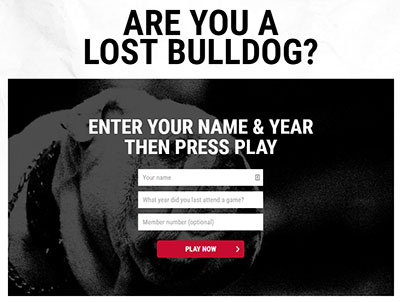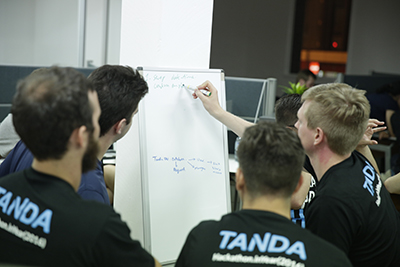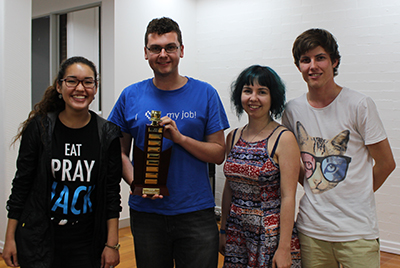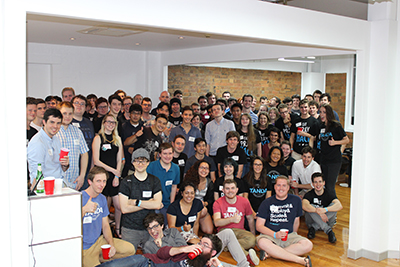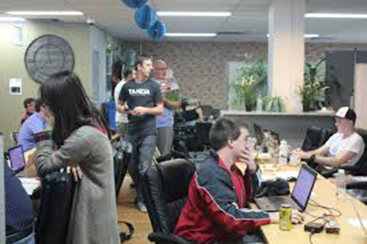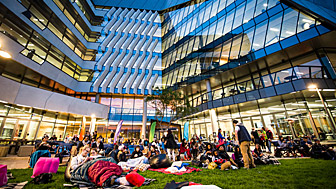Digital Business insights: Joined up thinking ... revisited
Digital Business insights by John Sheridan >>
ONE THING I have noticed over years of looking at digital strategies and regional economic development strategies is that they are all the same.
Change the name and the pictures and a few words, and bingo – another strategy saying exactly the same as the last one.
Sometimes they ARE exactly the same as the last one – the consultancy involved failing to change all the locational names properly when delivering the cookie cutter report to the next government customer.
So why do councils pay large amounts for strategies they could create themselves?
Is it laziness? Or fear? Lack of confidence? Stamp of approval?
Why not download the digital or economic strategy from another region and just change the names. It would be cheaper and the outcomes will be the same. 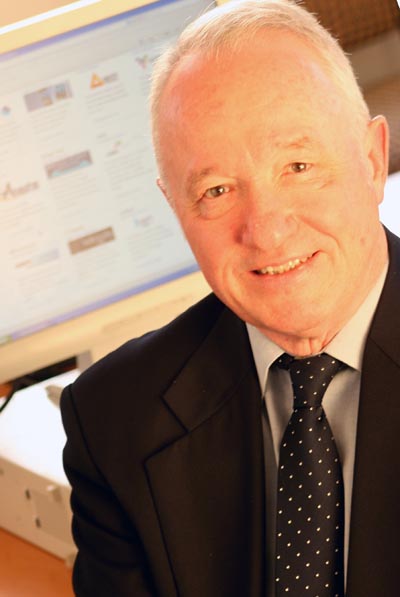
I noticed this first about 10 years ago. There was a common structure to all the economic development strategies that I read. Nothing has changed.
The first section was full of research, the information that defined the uniqueness of the region. The next section was full of reviews of what was changing, how the region compared with others, and what the future trends seemed to suggest. These sections were where all the hard analysis and thinking were being done.
The last section was where the cookie cutter came into action – future plans, the strategy for action and investment. This section was where hard analysis and thinking and uniqueness went out the window. Because this section required imagination and creativity which traditional planners are not trained to deliver.
So they fall back on platitudes and generalities often plundered from other economic development strategies from around the world. And the uniqueness of the region flies out the window with the rest of it.
What was intriguing to me as I reviewed strategy after strategy was that when it came to objectives, there was universal agreement.
They were always “We want things to be better”. Which is hard to argue with.
More jobs, more social amenities, more tourism, more large businesses moving into the area, more housing, better roads, better aged care, better schooling and so on.
We want to be leaders in…(insert an issue here).
You name it and put it in. That is what most economic development departments do. But there is never much detail on how all these things are going to be achieved … just a long list of wishes and dreams wrapped up in a professionally designed brochure, which the Mayor can be proud of.
Because thinking about the future is tough stuff.
Looking back is easy. Even pulling together all the statistics, tables and charts is achievable given enough time.
Looking forwards is very hard. And invariably wrong. Especially today with so many externalities shifting the solid ground we used to rely on.
Creating new solutions to old problems is even harder. It requires a different mindset.
And the two mindsets of deep analysis and insightful creativity rarely go together. That is why advertising creatives who have to do this to a brief, day after day are paid such large amounts of money and always have been.
Limited supply. And lots of burn out because of the stress.
And you won’t find these creative people in economic planning departments, or government or even large planning companies. Can’t afford them. And couldn’t attract them anyway.
Hence the cookie cutter approach to regional, digital and economic strategy.
Which is a problem for us all.
We actually need fresh creative thinking on regional, digital and economic strategy now like never before.
Because the world is changing swiftly and radically around us as a result of the digital revolution in a way that is largely invisible to most people.
And I hear all the time people saying, “Yes, I understand that – digital disruption isn’t it?” when in fact they don’t.
Because if they did…there would be more evidence.
There would be evidence in their strategies. There would be evidence in their actions. There would be evidence in the surety of direction.
But the evidence is largely in inactions, and “waiting to see”, and looking everywhere around the world for some sort of clue as to “what should we do?”
In the old days, cities had walls and when danger threatened, the drawbridge would go up, the gates would be shut, the soldiers would line the ramparts and the citizens would get ready for a siege.
The citizens and their leaders would hope they had enough water and food to wait out the invader. The strategy was “wait and see”.
Close the gates and agility, vision and mobility disappear for a while. In some cases this strategy worked well, but over many years invaders learned, and brought with them the tools – siege engines, cannons and mortars to defeat the people with “siege mentality” and walled cities fell out of favour.
Today we are seeing the same phenomenon repeated in response to the digital invader.
Walled cities. And the siege mentality that goes with it.
Once again we have surrendered maneuverability, agility, vision and responsibility (our ability to respond).
These are all useful attributes of the digital revolution. And we need them all.
The three major powerful currents of digital change – more connection, more collaboration and more integration are disruptive, provocative and remorseless.
They cannot be stopped.
They cannot be avoided.
Inaction is not a viable option. Nor is failure to recognise that walls don’t work any more.
Here is our digital strategy.
It is the digital strategy for my corporation, for Adelaide, Brisbane, Canberra, Darwin, for Gold Coast, for Sydney, for Queensland, for NSW. For anywhere and everyone.
And it is meaningless. Because the drivers for digital change are not constrained by the borders or boundaries of any city. And the citizens who live there – the individuals, the businesses and the not-for-profits are not constrained either.
Where is the knowledge economy? Where is the digital economy?
It is not in a place. It is in cyberspace.
Where are the borders? Where are the boundaries? Where are the walls? Where are the gates?
They exist only in the attitudes, the siloed thinking, and limited understanding of CEOs and decision makers who have not yet woken up to the real implications of this ongoing digital change. It needs joined up thinking.
It isn’t something that was dealt with last year and now we can shift the focus to innovation. Or jobs.
“We’ve done digital, now we are doing innovation”. I have heard that as well.
Guess what? You haven’t done digital or innovation or jobs. It all joins up.
“We will be the smartest city in the world”. We will attract the smartest individuals, smartest businesses and large corporates to our city.”
Dream on.
Every city will be the smartest city. Every obvious technological possibility will be milked by everybody … at slightly different speeds, but by everybody.
And in many cases the followers will become leaders, milking the technological possibilities more quickly because they carry no baggage and leapfrog the smug.
The real strengths of any region are what they have always been.
Its industries. Its people. The climate. Water. Culture. Access to the ports and airports. The interesting things to see and do.
Technology does not bestow unique advantage, but it can magnify and catalyse advantages that already exist.
That which is common to all is not a strength. But that which is unique could be.
The fundamentals haven’t changed. Technology is just an enabler. But a powerful and disruptive one like nothing we have ever seen before.
So cities, regions and states have to accept something has changed forever.
There are no edges any more (the city boundaries and city walls). The influence of geography is diminished. The power of the media is fragmented. Information is instantly accessible. The customer is informed and empowered.
That is confronting for political leaders – Mayors, Premiers, Prime Ministers – because their relevance is threatened.
But the digital revolution is much more than a threat, it is a promise, because these 19th century roles are steadily and remorselessly becoming less relevant.
It is no accident that politicians are nearly rock bottom when it comes to trust, along with insurance salespeople, real estate agents and talkback radio hosts.
In a digital environment where any statement or commentary is checkable and discussible … honesty and authenticity is mandatory.
So strategies of all kinds – social, political, economic, environmental and digital – have to align with the new reality to be useful and have to be rewritten to recognise the reality of the change.
'Maginot Line' thinking is a waste of time and money. Google 'Maginot Line' if you don’t understand the reference.
Connected. Collaborative. Integrated. There is a lot in these three words.
There are 55 RDA [Regional Development Australia] regions in Australia. Which is arguably as good a way as any to divide Australia.
Integrated regional strategies, not city or council strategies should be the first step. And not isolated regional strategies…but interconnected – vertically and horizontally. With the ultimate outcome being one interconnected, Australian strategy for every aspect of what we do. Joined up thinking.
Now, that is a step too far for our 19th century planners and policy officers at this time. It shouldn’t be … but it is.
Because we are still tied to outdated thinking that makes that practically impossible. “How would we do it?” “Who would do it?” “Who would pay?” “Who would decide to do it?” “Which minister would own it?”
But guess what? There are lots of examples of individuals and groups in Australia working on “joined up thinking” out of frustration with the obvious lack of big picture vision at the top, on many positive initiatives, using the internet to network and collaborate.
And if the digital revolution continues (ie no nuclear wars) we will all have to walk in this direction anyway. The digital revolution demands it.
19th century thinking in a 21st century digital revolution is where we mostly live today.
Like it or not, we have to start thinking in a different way.
That means collaboration and that means shared value – Google 'Professor Porter' on this.
In many ways it doesn’t matter what entities we use as the basis for collaboration. We can use those that already exist – councils, states and territories, corporates and individuals.
What does matter is the required “joined up” thinking and vision, and as a result the “joined up” strategies to reach the “joined up" goals.
We have to still do local. But we have to think global. Both at the same time.
Connected and collaborative strategies should recognise and incorporate the existing unique characteristics of a region, but all “future” plans and actions should be aligned with the characteristics of a “joined up” world.
These connected, integrated and collaborative realities must become second nature to our reinvented economic development thinkers. Are they up to it?
Cost sharing and value sharing are key parts of the methodology. Not easy. Who pays? Who profits? But even this can be worked out and agreed. If we can go to the moon in 1969, we can work out how to collaborate in 2016.
We are all heroes in the digital revolution. We have to be a 21st century team of collaborative but independent thinkers. Joined up thinkers.
Only by pushing personal or party glory into the background can consideration be given to greater good, longer-term plans and possibilities. We used to call that vision and it has been missing for a while.
So our focus has to shift towards shared value collaboration so we can all benefit in our much bigger competition with the rest of the world. In the digital revolution no man is an island and no island is an island either, no matter how big it is.
If there are no existing mechanisms for effective collaboration we have to invent them and quickly. COAG, councils of Mayors, RDA network, whatever grouping is most useful … need to evolve swiftly into real platforms for action.
The digital revolution takes no prisoners.
And the countries that move fastest to reorganise will be the winners.
John Sheridan is CEO of Digital Business insights, an organisation based in Brisbane, Australia, which focuses on helping businesses and communities adapt to, and flourish in, the new digital world. He is the author of Connecting the Dots and getting more out of the digital revolution. Digital Business insights has been researching and analysing the digital revolution for more than 15 years and has surveyed more than 50,000 businesses, conducting in-depth case study analysis on more than 350 organisations and digital entrepreneurs. Now DBi is turning that research into action through a series of digital business development platforms, the first of which launched this month: the Manufacturing Toolbox.
ends


